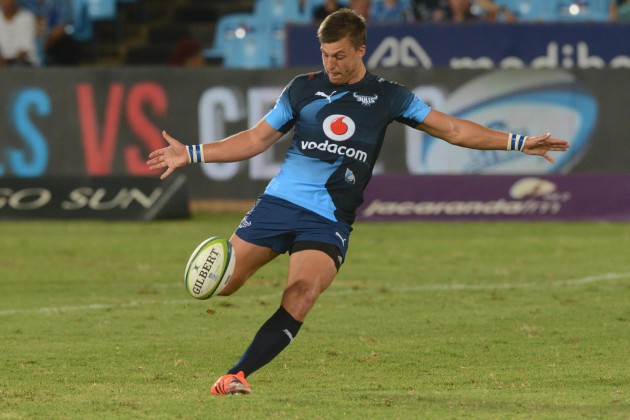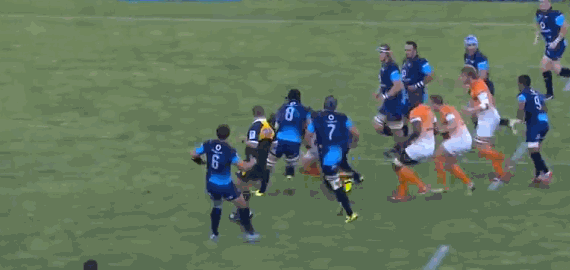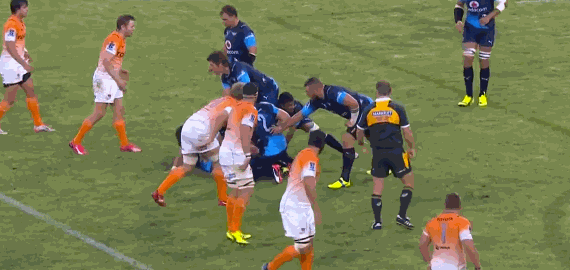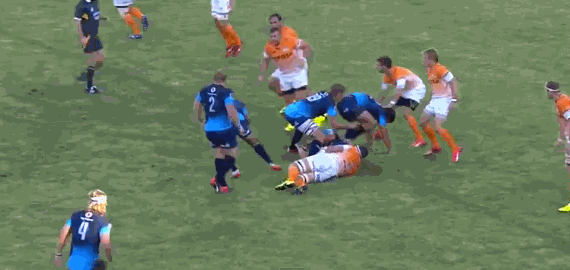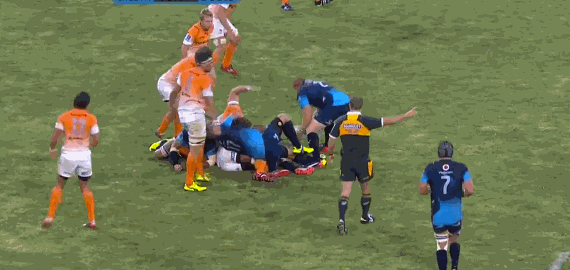South African sensation Handre Pollard turns 21 on Wednesday and celebrated with a stunning performance this weekend. We analyse the efforts of the Bulls fly-half.
Reaching the coveted milestone of 50 Tests in Paris just over a week ago, George North underlined a trend of modern rugby. Barring the odd anomaly such as Keven Mealamu or Nick Easter, it is truly a game for young men.
At 22 years and 321 days old, North, the Wales and Lions wing became the freshest face to land a half-century of internationals. It is easy to forget his debut arrived at the tender age of 18 back in November 2010.
Historically, the southern hemisphere superpowers have been more willing to blood their most promising youths. Think South Africa‘s Eben Etzebeth or Wallabies James O’Connor and Liam Gill in recent times. But Stuart Lancaster is a big advocate of fast-tracking too, as a backline featuring George Ford, Anthony Watson and Jack Nowell – a trio of 21 year-olds – demonstrates.
The moral of this story is that sometimes talent is simply impossible to ignore. Reigning World Young Player of the Year Handre Pollard is the flagbearer for this category.
Already the proud owner of nine Springbok caps including a two-try outing to beat New Zealand last September, the prodigious, precocious fly-half celebrates his 21st birthday on Wednesday. By happy coincidence, he produced a phenomenal all-round performance in a 39-20 victory for the Bulls over the Cheetahs on Saturday.
A full house of a try, five penalties, three conversions and a drop-goal comprised his 29-point haul, while there was also an assist, some sturdy defensive work and canny game management. Here is a run-down of Pollard’s display.
Defence: organisational authority
At six foot, two inches tall and weighing 96 kilograms, you would not expect Pollard to shirk much in the way of collisions. Then, given his relative inexperience, he might be forgiven for taking a back seat in terms of directing defensive patterns. Watch this sequence from the first half, and think again:
A muscular challenge on Boom Prinsloo stalls the Cheetahs’ momentum comprehensively. It was one of eight tackles Pollard made in the match, without missing one.
More impressive though, is the communication. At the previous ruck, Pollard identifies that the Bulls are short on numbers, and gestures in a bid to bring his forwards over to the openside:
The response is swift. Obeying their conductor, locks Victor Matfield and Jacques du Plessis skirt around to fill in around the fringes either side of openside flanker Pieter Labuschagne, ensuring the Cheetahs are well marked:
The authority and conviction Pollard shows here were mirrored when the Bulls had possession.
Exit strategy: thumping downfield
Decisiveness and accurate execution are important in every aspect of a number ten’s armoury, not least when attempting to assert territorial control at a restart. Pollard’s siege-gun right boot – which we will get onto in more detail later – gave the Cheetahs no scope to pressurise or spoil.
Here are two examples, both from the second half. One clearance sails from right to left…
…the other from left to right:
Both passed the halfway line and landed in the stands, nullifying any hope of a quick lineout and thoroughly disheartening the Cheetahs.
Back-field coverage
With aerial exchanges so prominent these days, a significant part of the fly-half’s role comes away from the gain-line. The Cheetahs boast Willie Le Roux among their ranks, an exceptional full-back who sniffs out space so well, so guarding the back-field was even more crucial on Saturday.
This bout of kick-tennis gave evidence of Pollard’s positional awareness:

It is worth isolating the moment Francois Hougaard launches his counter and looks to chip over the line of Cheetahs chasers. Notice how Pollard holds his ground, covering the area left empty as Hougaard heads forward:
Sure enough, as Le Roux gathers and sends the ball back, Pollard is in a perfect place to collect and assess his options:

Seeing tight forwards ahead of him, Pollard carries into midfield, beating second-row Carl Wegner with a step off his right foot and setting up a target for his support runners:
Goal-kicking: downright deadly
Even allowing for the fact that Bloemfontein is 1,400 metres above sea level, meaning kicks travel for miles through the thinner air, Pollard hit the ball brilliantly off the tee.
Eight successful strikes from eight attempts represented his final return, and some of them were superb. This touchline conversion of Bjorn Basson‘s score (again, more detail shortly) was excellent:
Likewise, this 51-metre three-pointer:
Such range is a fantastic weapon, not just as a means of ticking the scoreboard over, but also because the opposition know it is a huge risk to concede a penalty anywhere inside their own half. It is a claustrophobic feeling.
Phase-play: distribution and drop-goals
Standing at first-receiver is all about selecting options. In terms of passing, timing is the fundamental skill. Sometimes a delayed release will get the job done, on other occasions it is best to shift early in order to ‘feed the speed’ of those wider out.
Pollard does exactly the latter in this instance, from another restart return. His wide pass sets a sweeping movement away and full-back Jessie Kriel can make ground close to the left touchline:
On the half-hour, the Bulls got in behind the Cheetahs on the back of a barnstorming charge run from hooker Adriaan Strauss. Following up, Pollard again opted to release his pass early in order to make full use of the width available.
As Basson went over, his decision was justified:
The assist from JJ Engelbrecht is a fine one, but Pollard’s strong, flat ball to Matfield is what injects pace into the attack, forcing the veteran lock to speed onto an outside arc and manufacture a three-on-two:
With around 15 minutes to go and the Bulls leading 29-20, Pollard helped take the sting out of a Cheetahs comeback by directing a fluent attack that ended in a well-struck drop-goal.
It started as the visitors gleaned a penalty advantage and probed in the outside channel:
As the Bulls worked their way up to just outside the 22, Pollard stepped back into the pocket. His forwards come around the corner to hold the Cheetahs defence…
…but Pollard takes Rudy Paige‘s pass and sends the drop-goal through the middle of the posts:
The reverse angle offers a better idea of how true the contact is:
This entire sequence demonstrates Pollard’s management of the cadence of this encounter. He commanded its cut and thrust.
Gain-line threat
At the beginning and end of the game, Pollard made two interventions directly leading to tries. First, this show-and-go saw him power over with only 10 minutes gone:
Examining Pollard prior to receiving Paige’s pass is telling. As the Bulls forwards recycle, he is scanning the defensive line in front of him, searching for potential openings:
From behind the posts, we can see the area Pollard attacks, exploiting a mismatch against the slower Wegner. Speeding onto the second-row’s outside, he takes advantage of a weaker arm tackle to dive over:
Far later in the contest, in the dying ten minutes in fact, Pollard received the ball in a similar position. Again a try resulted, although this time it came about in a different manner:
Undoubtedly aware of Pollard’s ability to crash through himself, Cheetahs replacement centre Willie du Plessis closes off ever so slightly in an attempt – perhaps even a subconscious one – to cover his fly-half Joe Pietersen:
The angle of du Plessis’ body makes it difficult to turn and stop the hard line of Jan Serfontein as the Bulls centre steams onto Pollard’s pass:
Pollard is now up to 72 points from four Super 15 appearances this campaign, leading an inexperienced Bulls outfit to two wins. His ability to vary things and produce pieces of magic adds a touch of devil to increasing maturity.
Maintain this form, and he is sure to be Heyneke Meyer’s man for the World Cup and way, way beyond.





